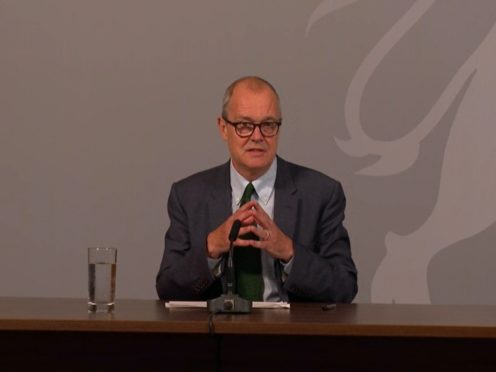The UK’s chief scientific adviser has warned that if the number of coronavirus cases continues to double at its current rate there would be 49,000 new cases by mid-October.
Sir Patrick Vallance said that cases are doubling every seven days across the UK, and used a graph to show that its existing rate, by the middle of next month there would be 49,000 cases – with “200 plus” deaths a day by mid November.
“At the moment we think the epidemic is doubling roughly every seven days,” he said.
“If, and that’s quite a big if, but it that continues unabated and this grows doubling every seven days… if that continued you would end up with something like 50,000 cases in the middle of October per day.
“50,000 cases per day would be expected to lead a month later, so the middle of November say, to 200-plus deaths per day.
“The challenge therefore is to make sure the doubling time does not stay at seven days.
“There are already things in place which are expected to slow that, and to make sure that we do not enter this exponential growth and end up with the problems that you would predict as a result of that.
“That requires speed, it requires action and it requires and it requires enough in order to be able to bring that down.”
Chief medical officer for England, Professor Chris Whitty admitted that the “seasons are against us” as he laid out the impact the spike in cases will have on NHS, patient waiting times, employment and poverty levels.
He urged people to “break unnecessary links” between households by reducing social contact at work and at home but acknowledged it was a “balance of risk”.
“If we do not change course we are going to find ourselves with a difficult problem,” Prof Whitty said.
Sir Patrick said that under 8% of the population have been infected and the vast majority of us are not protected.
However he said there had been good progress in developing vaccines.
Both Sir Patrick and Prof Whitty urged the public to take responsibility for stemming the spread of the virus – not just for themselves, but for the wider population.
Prof Whitty said: “What we’re seeing is a rate of increase across the great majority of the country.
“It is going at different rates but it is now increasing.
“And what we’ve found is, as we go through in time, anywhere that was falling is now moving over to beginning to rise and then the rate of rise continues in an upwards direction.
“So, this is not someone else’s problem, this is all of our problem.”
Sir Patrick added: “The way that we reduce the spread is by limiting our number of contacts, by reducing contact in environments where spread is more likely – those are crowded environments, indoor environments, poor ventilation – and making sure that we reduce the probability of coming into contact with anyone who is infectious.
“And that’s the importance of self-isolation, keeping out of circulation if you have, or may have, the virus.”
